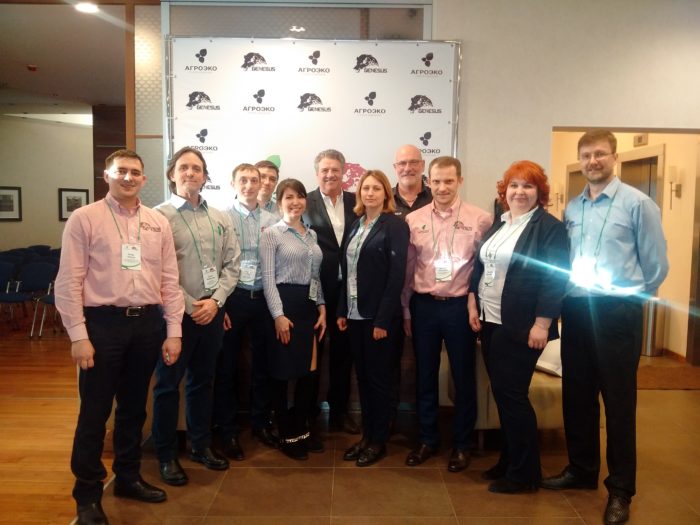Russia Road Trip
Last week we spent in Russia. Arrived on the weekend in the midst of Russia elections. Sunday afternoon in Moscow, we were at Red Square, but it was closed due to elections. A lady walked by, asked if we were foreigners (maybe it was the Genesus coat?). She thought it would be nice to give us a metal button that said we had voted? Kind of funny. Anyway, if you didn’t hear, President Putin was re-elected; it was not a surprise to the Russians we spoke too.
Monday, we spent in the Black Earth area, 500 miles south of Moscow, which is the heartland of the Russian swine industry.
The Black Earth area has some of the best cropland in the world, with topsoil 3 feet deep. Russia, over the last years, has increased grain production significantly with last year having the largest grain crop ever. Farms are massive, with companies we visited having land bases of over 200,000 acres (100,000 hectares). Over the last few years its been a bonanza for John Deere, Case etc. as the expanding industry modernised. One company we visited had just received delivery of 65 new combines.
As in the US Midwest, where is grain you end up with swine operations. The industry has developed greatly in the last 10-12 years, with large scale new barns built. For a while operations were two to three site operations, but current trend for new farms is farrow-to-finish on site. This mainly due to African Swine Fever, to have less movement of pigs and have fortress bio-security in one spot.
African Swine fever is a real danger and if you get it, all pigs are destroyed with little government compensation. Last year some Genesus customers got African swine Fever with a total of 10,000 sows and their offspring’s being destroyed. It is a huge financial hit. Now its open season on wild boars with the goal of eliminating them as they are believed to be the main vectors of the disease.
Russia has had sanctions, preventing European and North American Pork coming to Russia. Recently Brazil has been added to the list of countries. Today Russia has virtually no Pork imports. The Brazil ban was done to primarily support Russia hog prices which had declined.
Russia is perceived to be close to be self-sufficient on Pork. That is assuming a static per capita consumption of Pork at around 44lbs (20kg) times about 145 million people. Russians like meat and spend 7.5% of their income on meat and poultry, the highest percentage we can find it the world. To us that says there is upside for Russia pork consumption if Pork becomes less expensive. We expect Russians to eat more pork if their income rise. Europeans eat between 40-50 kg of pork per capita (90-100 lbs), they don’t eat much beef. We expect Russia to follow the same pattern; if that’s the case, the calculation for self-sufficient becomes a moving target. A doubling of per capita consumption in Russia to equal European per capita consumption, means Russia would need 1.5 million sows more.
The Russian pig industry is talking of exporting pork, primarily to Asia. If African Swine Fever issue can be resolved for exports, Russia has globally competitive grain costs, the land base, and now the developed production knowledge to be a strong competitor. Production on many farms is Russia now are as good as any in the world.
Last week Genesus gave seminars to producers that combined have 35% of the Russia swine production. This group has collective plans to add over 200,000 new sows over the next three years. At the same time the Russian Pig Federation is warning producers not to expand. Go figure? Like all markets it’s a crap shoot of what is the right strategy.
Building costs have gone up 30% in Russia the last couple of years as cement and steel have appreciated. As most, loans are on an eight-year amortisation, cash flow pressure is intense. The wild card in the market to some extent is the old soviet farms build over thirty years ago with less than ideal productivity or costs. High profit margins in the last few years has kept these operations in business; we wonder if there is a real drop in Russia prices if these operations close rapidly. There are probably still around 300,000 sows in this type of operations.
For Genesus, we find continued growth in Russia for our genetics. A large operation comparing a 4800 sow Genesus to 4800 sows Danbred – Genesus had 5,000 more market hogs over the course of a year, 10 days sooner to market and lower feed cost per head. They will be doing more business with us for some obvious reasons.
Genesus has now the largest registered purebred base in Russia of any swine genetic company. Our Russian team continues to grow the business.
One of the interesting parts of our job is we get to travel the world. We meet people and more particularly meet pig producers. What we find, is the commonality of people. Pig farmers are the same everywhere; practical, down to earth and family oriented. They want to be the best and be successful, they are people with a view to the future – build barns, grow grain, breed pigs and hope market will be okay. We are more the same then we aren’t.
It is estimated the world needs to double food production by 2050. That will be about 80 million more sows? Where is it going to be done? Our thought is, some here, some there; there will be room for producers that adapt technology and human productivity enhancements.
The global pork industry has to meet some short-term issues but in the long-term the need for more food-pork is a great opportunity
Categorised in: Featured News, Pork Commentary
This post was written by Genesus




